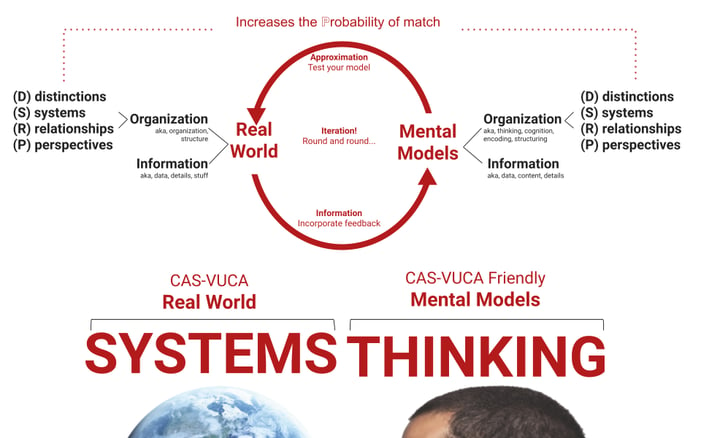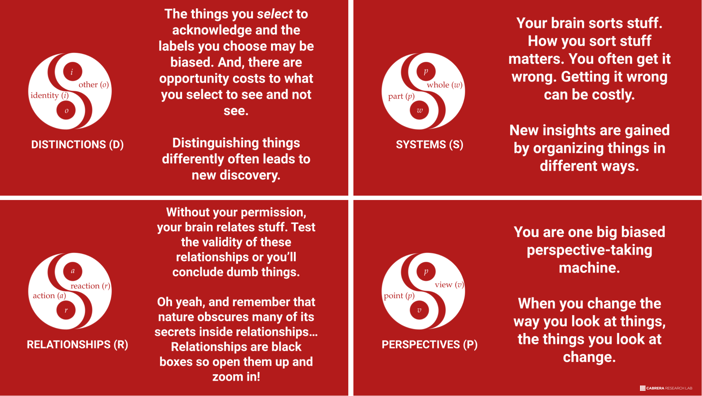Want to get good at Systems Thinking? Do these 5 things...
 Derek & Laura Cabrera
·
4 minute read
Derek & Laura Cabrera
·
4 minute read
The "Systems Thinking/ DSRP Loop" (below) captures Systems Thinking in a nutshell. The Loop helps us by understanding the simple rules for the organization of any thing, from material stuff to information and ideas.
The entire point of systems thinking as a field is to help ameliorate discrepancies between our mental models and the real world—to increase the probability that our mental models are in alignment with reality. In other words, ST is a bridge between our mental models (how we think the world works) and reality (how it actually works). And, this “bridge” is actually a very powerful feedback loop between the real world and the metal models - or the way we think about things.
Remember, both everyday and wicked problems result from the mismatch between how real-world systems work and how we think they work—between our mental models and reality.

But, you could conceivably spend years understanding just the single image above at greater and greater depths. So, people ask us, how do I get started? Here's 5 things to get you started mastering Systems Thinking/DSRP:
.png?width=702&name=Untitled%20presentation%20(6).png)
First, we have learned that becoming a systems thinker is something you take in little bites daily. Don’t try to swallow the elephant whole. That is why we created Systems Thinking Daily…
So go join that group on your preferred platform:
- Systems Thinking Daily Group on Facebook
- Systems Thinking Daily Group on LinkedIn
- Systems Thinking Daily on Twitter
- Systems Thinking Daily on Instagram
- Systems Thinking/DSRP Courses Discussion Group on Slack
Then, start practicing. It won’t implement itself. Your thinking isn’t going to change without a little work on your part.
In decades of researching, teaching, and learning Systems Thinking, we've learned one important thing...You MUST commit to the daily practice of burning the neurons.
.png?width=700&name=Untitled%20presentation%20(15).png)
.png?width=700&name=Untitled%20presentation%20(8).png)
Second, start basically… whenever you see the acronym DSRP, just think...“Information is selected, sorted and connected by frames of reference.”
This is the simple, English formulation of DSRP Theory. It captures most of what is captured in the much more complex and technical mathematical formalism. Think of this simple sentence in this way: Darwin's Theory of Evolution is a tremendously important and provides a deep theoretical understanding of how nature works. But we can encapsulate or summarize all of what Darwin was saying in a simple statement: "descent with modification through natural selection."Now, you could spend your lifetime understanding that statement in greater depth, but as a summary, it is understandable and does a good job.
As you can see, DSRP is quite simple. DSRP is saying something very elemental about the world. It isn’t complicated, you can understand it. The biggest mistake folks make is to underestimate how profound this simple statement can be. Take some time with it…so that you come to realize how such a simple statement can communicate so much.
.png?width=697&name=Untitled%20presentation%20(7).png)
Once you understand that "“Information is selected, sorted, and connected by frames of reference”— that both mind and nature are organized by DSRP—it's time to take the next step.
.png?width=700&name=Untitled%20presentation%20(10).png) Third, start with some basic questions. You can use these four questions as an easy starting place for ANY issue, problem or process you are trying to understand. Just start with the 4 simple questions; these will act as training wheels for using DSRP at a much more complex level where you realize that the four patterns can be mixed and matched in an infinite number of ways.
Third, start with some basic questions. You can use these four questions as an easy starting place for ANY issue, problem or process you are trying to understand. Just start with the 4 simple questions; these will act as training wheels for using DSRP at a much more complex level where you realize that the four patterns can be mixed and matched in an infinite number of ways.
- (D) What things are we selecting to see/not see?
- (S) How are these things organized?
- (R) How are these things related?
- (P) From what or whose perspective?
You can find more advanced questions at Thinkquiry here.
.png?width=700&name=Untitled%20presentation%20(9).png)
Try out these questions for a week and see how your mind and your awareness (metacognition) changes. Pay attention to what you noticed that you didn't notice before... Now that the questions are sinking in, let's take it to the next level...
.png?width=699&name=Untitled%20presentation%20(12).png)
Fourth, learn some of the finer detail of the four universal structural patterns of DSRP--like the fact that each is made up of two elements. This is important for doing more technical, sophisticated, analysis of systems. Commit these patterns and their two co-implying elements to memory.
What this means is understand the patterns and then pay attention in work and life and everyday moments how they are playing out constantly.
- We make distinctions constantly; when we do we identify something as salient and in doing so ignore or create an “other”
- We constantly sort, group and ungroup stuff. When we do we are messing around with the organization of parts and wholes
- We constantly relate stuff. When we do we are saying something about how one thing acts upon another and the reactions that result
- Everything we think, we think from a perspective or “frame”. This frame is the point and what we see as a result is the view.

|
Patterns |
Equals = |
Elements |
||
|
Element1 |
Coimplies ⇄ |
Element2 |
||
|
Distinctions (D) |
identity (i) |
other (o) |
||
|
Systems (S) |
part (p) |
whole (w) |
||
|
Relationships (R) |
action (a) |
reaction (r) |
||
|
Perspectives (P) |
point (ƥ) |
view (v) |
||
.png?width=700&name=Untitled%20presentation%20(11).png)
It is at the level of Elements that the power of DSRP really kicks in. Once you realize that DSRP isn't really about the D, S, R, and P but is instead about their elements (i-o, p-w, a-r, and p-v) and their marvelous interactions, you'll be amazed at how sophisticated your thinking start to become. Now you're ready for the next step.
.png?width=698&name=Untitled%20presentation%20(14).png)
Fifth and finally, start mapping. Mapping provides a visible, tangible, product of systems thinking. Get you ideas out of your head (a bias factory) and out on paper (or onscreen or on a whiteboard) in the light of day.
Your faculty members will be showing you how to map, but DSRP provides you with the kind of structural questions to ask to find the right answers to the systems and problems you are trying to solve.
We have seen that when people map, they start to get the full benefits of systems thinking. Plectica software was invented to help people do advanced systems mapping, but you can use pencil and paper, whiteboard, or post it notes as well.
.png?width=700&name=Untitled%20presentation%20(13).png)
Mapping brings it home. It makes Systems Thinking tangible and visual! It'll feel a little clunky at first, but try it out and soon you'll not remember how you thought things through before you started mapping.
++++
.png?width=150&height=150&name=CRL%20GOAT%20Logo%20(4).png)




